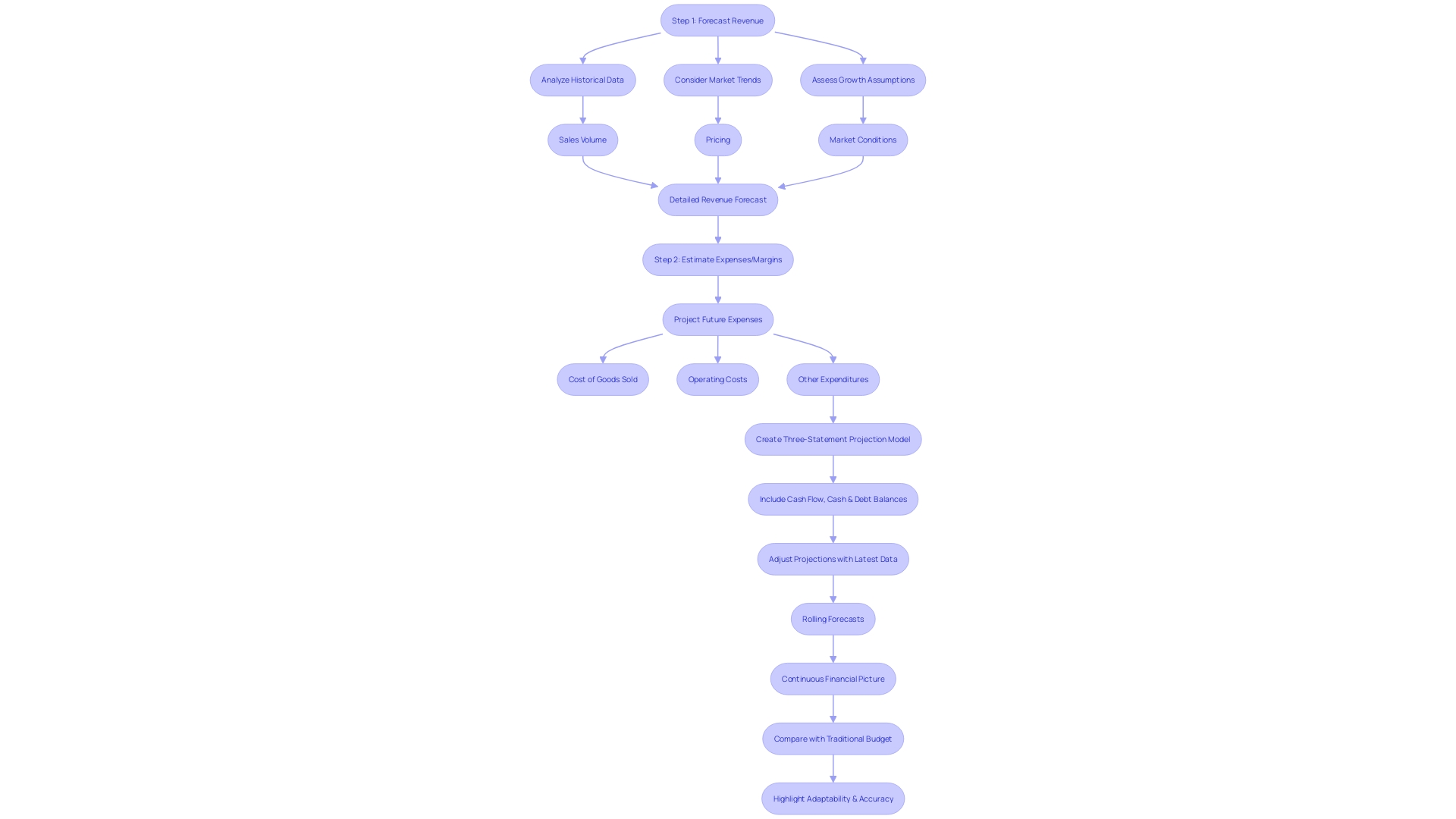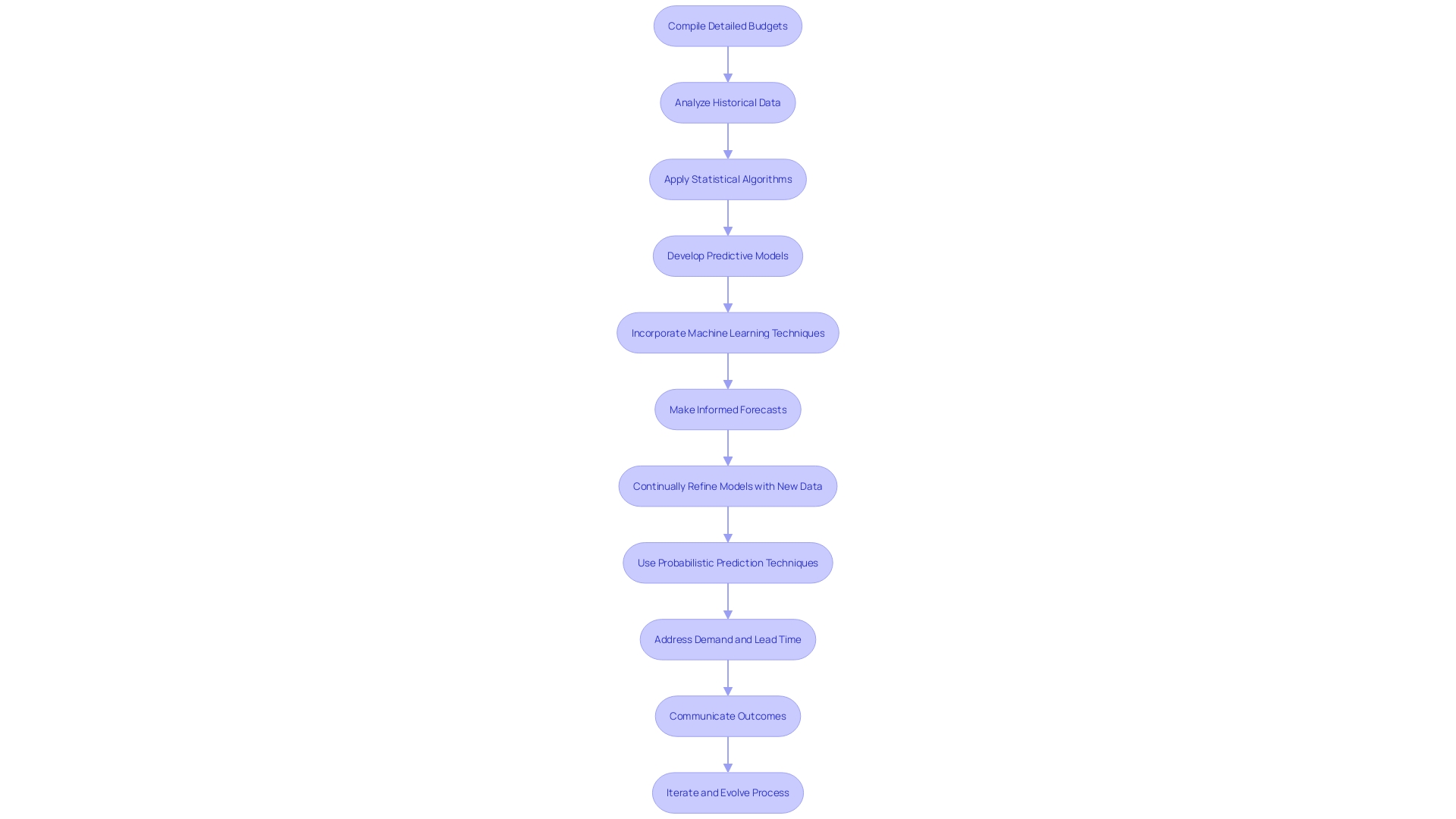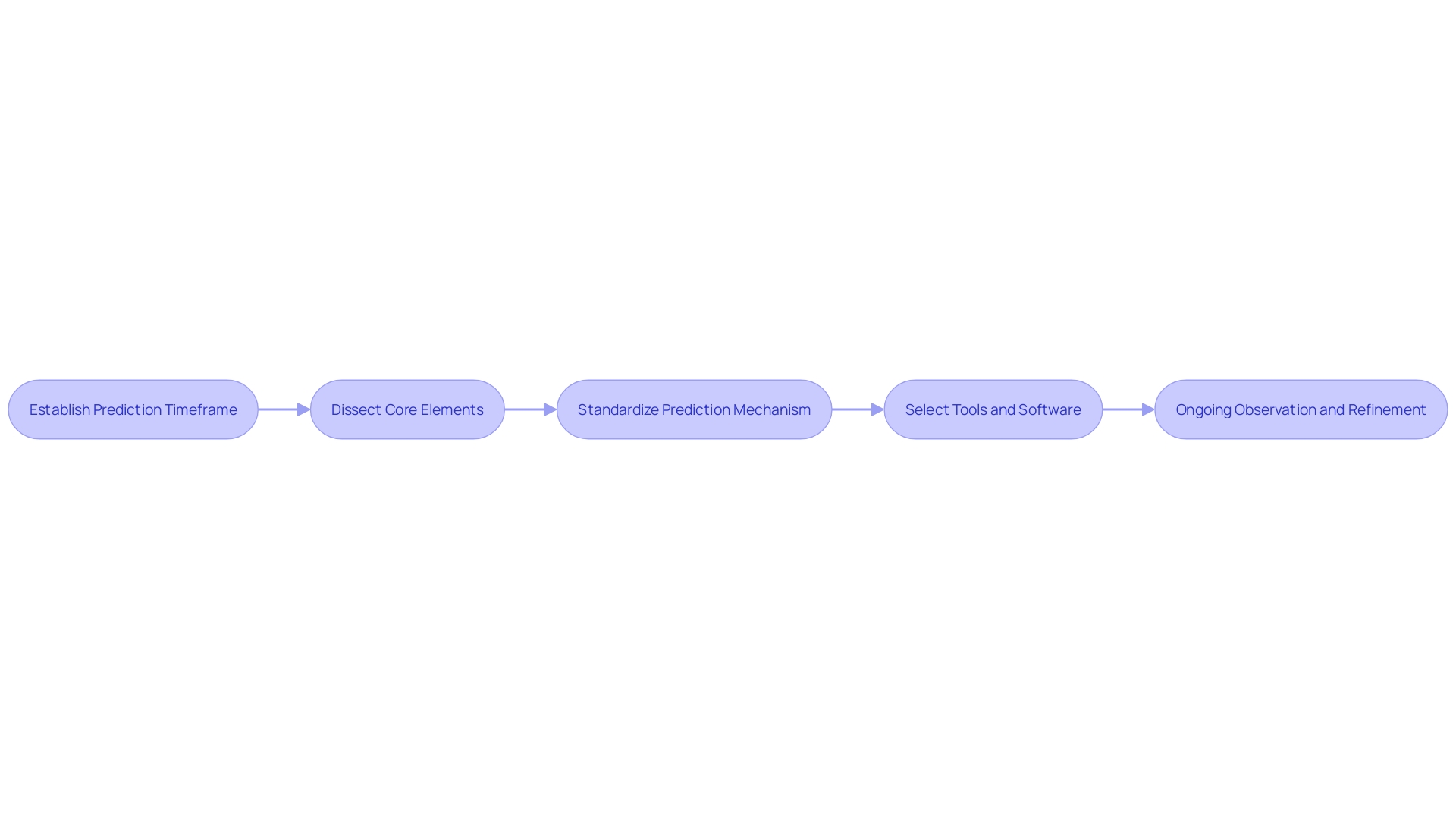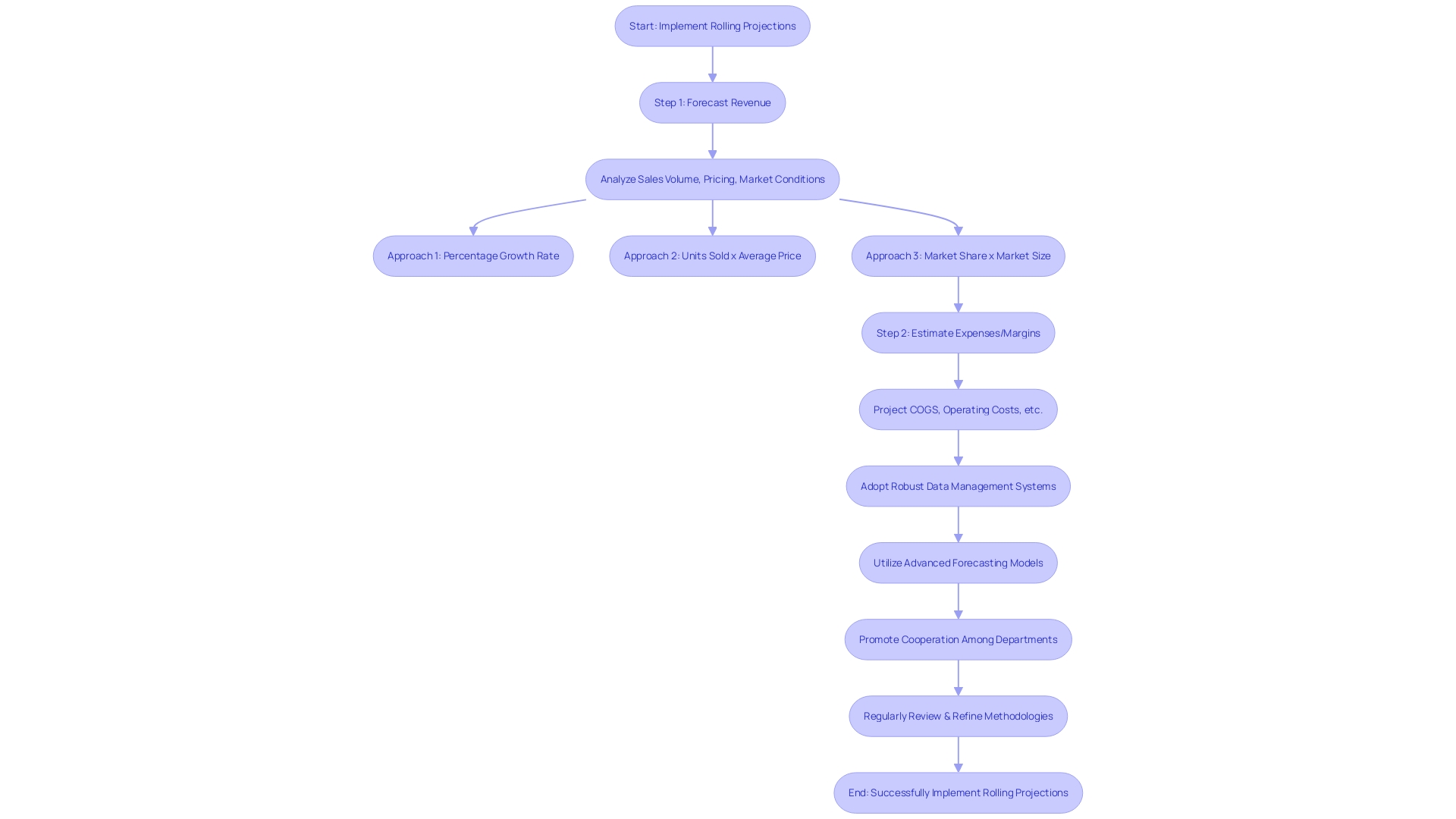Introduction
Rolling forecasts are a crucial tool for financial planning, providing organizations with continuous insight and adaptability in a rapidly changing market. In contrast to traditional budgets that quickly become outdated, rolling forecasts offer a forward-looking projection that incorporates the latest data, resulting in a more accurate financial picture. This article explores the types of rolling forecasts, the benefits of using them, best practices for implementation, and common challenges and solutions.
By embracing rolling forecasts, organizations can navigate the uncertainties of modern financial markets with confidence and make informed, data-driven decisions.
What is a Rolling Forecast?
Rolling forecasts are pivotal for staying agile in an ever-evolving market landscape. They serve as a continuous, forward-looking projection that adjusts to include the latest data, offering a more accurate financial picture for the coming months. This contrasts sharply with traditional budgets, which often remain static and may quickly become outdated.
Consider Roper Technologies, a company recognized for its strategic focus on generating and reinvesting cash flow, a principle that likely informs their forecasting approach. Their approach demonstrates a comprehension that the adaptability of ongoing projections can support effective long-term investment plans.
Additionally, ongoing projections correspond with the realities of the current dynamic business environment. The European market leader in online gambling is an example of a company benefiting from ongoing forecasts. This industry, expected to grow at a CAGR of 12% until 2030, demands an approach that accommodates rapid growth and change.
Integrating rolling averages into a company's analysis simplifies trend spotting. By focusing on a specific subset of data points, organizations can discern patterns over a 12-month period, for example, to better anticipate sales trends.
The differentiation between budgeting and anticipation is critical. While budgeting establishes monetary objectives, predicting future performance based on previous and present data guides both the initial budget and ongoing modifications. A quote from the M6 forecasting competition paper underscores the practical benefits of forecasting in making informed investment decisions.
With the dual challenges of predicting complex markets, which methods such as the ones discussed in the arXiv preprint paper attempt to address, ongoing predictions provide a means to bridge the gap between technical and fundamental analysis, offering a more comprehensive tool for planning.
Hence, embracing ongoing predictions is more than a strategic decision; it's a requirement for businesses aiming to navigate the unpredictable waters of contemporary monetary markets with assurance.

Types of Rolling Forecasts
Rolling predictions are crucial tools for economic planning, providing flexible and ongoing insight into an organization's fiscal condition and assisting in strategic decision-making. A 12-Month Rolling Forecast delivers monthly projections for a full year, offering granular insights into short-term performance metrics. For a broader perspective, a Rolling 4-Quarter Forecast expands the outlook to encompass quarterly periods, ideal for capturing seasonal variations and trends. Looking further ahead, a Rolling 3-Year Forecast can provide a strategic vista over a multi-year span, identifying long-term trends and potential risk areas.
Establishing these predictions starts with a strong financial plan. Managers compile detailed budgets, which are then consolidated by leaders and ratified by stakeholders. The process, while seemingly straightforward, requires meticulous coordination and expertise. With each iteration of the prediction, its importance increases, especially as the fiscal year advances. This evolving nature means the forecasts can dramatically shift the financial narrative of an organization as new data emerges.
Incorporating probabilistic prediction techniques further refines these models. By assigning probabilities to different outcomes, organizations can navigate uncertainty with greater confidence, ensuring more robust decision-making, especially in complex systems like supply chains where demand and lead times are critical.
The effective communication of prediction outcomes is as crucial as their creation. It's about converting data into actionable intelligence that can guide an organization towards its monetary targets. The ever-changing nature of prediction requires continuous improvement to maintain consistency with evolving business landscapes and product quality enhancements.
Recent developments in statistical and machine learning techniques have improved the accuracy of financial prediction. These quantitative approaches, expressed through probabilities, reduce communication errors and elevate the decision-making processes, as seen in various sectors.
The significant influence of quantitative prediction on strategic choices is emphasized by insights from the M6 prediction competition and the Center for Inflation Research. These resources underscore the importance of accurate economic trend analysis and forecasting, both for individual regions and the broader economic landscape.
To sum up, whether it's a comprehensive month-by-month examination or a strategic multi-year review, rolling projections serve as essential instruments, directing organizations through the intricacies of planning and enabling well-informed, data-driven choices.

Benefits of Using Rolling Forecasts
Rolling projections are a pivotal tool for organizations, providing a dynamic approach to planning that aligns closely with market conditions and operational needs. These predictions facilitate an agile reaction to market changes by enabling decision-makers to adapt based on up-to-date data, thereby enhancing the accuracy of monetary projections and reducing unexpected elements. They foster a sense of accountability across departments, ensuring that individuals and teams are aligned with the monetary objectives and contribute to a culture of transparency. Moreover, ongoing predictions enable strategic allocation of resources, emphasizing regions of possible inefficiency or underutilization for corrective measures. These insights are crucial for strategic planning, offering a lens into future economic scenarios that can shape informed, strategic decisions.
The establishment of a dynamic projection starts with a strong base, usually an elaborate budget that mirrors the combined input from departmental managers, is enhanced by fiscal leaders, and is authorized by governing entities. Incorporating optimal methods in the development of continuous predictions is essential for their efficiency. Efficient communication of the insights derived from these predictions is equally crucial, guaranteeing that all stakeholders are informed and can participate in guiding the financial direction of the organization. As organizations increasingly recognize the value of rolling forecasts, their utilization becomes more prevalent, with an emphasis on their strategic importance in the latter part of the fiscal year.
Recent studies, such as the paper titled 'Threshold-Based Algorithms for an Online Rolling Horizon Framework Under Uncertainty -- With an Application to Energy Management,' highlight the importance of predicting in managing intricate systems with inherent uncertainty. In the context of supply chain operations, where demand and lead times are critical, probabilistic prediction models have proven to be essential, offering a range of potential outcomes rather than a singular estimation. These models enable organizations to make robust decisions in the face of unpredictability.
The global investment landscape also highlights the need for detailed risk assessment and prediction. Reports indicate that over the next three decades, investments in infrastructure, particularly for renewable energy and climate change adaptation, are expected to exceed $100 trillion. This massive influx of capital requires accurate and flexible prediction models to navigate the changing economic and geopolitical risks. For instance, the growth of emerging market green bonds, which surged by 45% in 2023, is projected to continue expanding, with a forecasted annual growth rate of 7.1% through 2025.
Canadian pension funds' $2.6 billion investment in the Asia-Pacific region in 2023 reflects the strategic application of forecasting in guiding investment flows, which have been growing significantly over the past two decades. This activity demonstrates the practical implementation of dynamic predictions in shaping investment strategies that are adaptable to global trends and opportunities. In general, the acceptance and improvement of continual predictions are essential to the economic flexibility and long-term vision required for organizations to prosper in today's intricate economic environment.
How to Create a 12-Month Rolling Forecast
Starting the process of developing a 12-month rolling projection, it's crucial to commence with a clear plan. The prediction serves as a guide, directing strategy with accuracy and flexibility. The first step establishes the prediction in time, concentrating on the next 12 months.
Next, it is imperative to dissect the core elements that pulsate through your organization's financial heartbeat. These elements may range from sales volume and market trends to pricing strategies and operational expenses. By dissecting and scrutinizing these value drivers, one can sculpt forecasts that are not only accurate but also ripe for strategic action.
The third step in this odyssey is the standardization of the prediction mechanism. This ensures a harmonious process by clearly delineating roles, refining data collection, and enforcing a disciplined update regimen.
A critical component of this process is the selection of robust tools and software designed to augment the forecasting process. These digital companions offer a suite of advanced analytical prowess, empowering organizations to navigate the financial seas with greater ease.
Finally, the prediction is a dynamic entity that flourishes through ongoing observation and refinement. It demands vigilance to remain relevant, adjusting its sails to the ever-changing winds of business dynamics and unfolding trends.
For instance, Auchan's experience across Ukraine, Romania, and France highlights the significance of a flexible model that adapts to local nuances, ensuring that forecasts are as localized as they are global.
As we explore further into the domain of forecasting, it's crucial to adopt both statistical and machine learning approaches, as emphasized by the M6 forecasting competition. These cutting-edge approaches can illuminate the path forward, melding traditional financial acumen with modern analytical tools.
Essentially, an ongoing prediction is not just a collection of figures; it is a strategic structure that constantly develops, guiding choices and influencing the financial future of an institution.

Best Practices for Rolling Forecasts
Achieving optimal projections requires a seamless combination of long-term planning, backing from top management, and technological effectiveness. Initial steps should involve establishing a budget as a foundational tool for crafting a rolling forecast. This budget should be carefully put together by department managers, overseen by leadership, and sanctioned by the brand and ownership. Such rigorous preparation, while challenging, sets the stage for more accurate economic predictions and impactful planning.
With strategic goals as the compass, the ongoing projection must be meticulously aligned with the organization's overarching objectives. This alignment ensures that every financial decision and resource allocation propels the organization towards its desired future state. Gaining executive support is not just a mere formality; it is crucial for the projection to be integrated into the organizational structure, instilling accountability and a proactive planning culture.
Cross-departmental collaboration stands as a pillar of effective forecasting. By engaging various stakeholders, the projection gains from a variety of perspectives, resulting in a more resilient and comprehensive outlook. To further strengthen the credibility of the prediction, standardizing data collection and analysis processes becomes essential. Clear definitions of data sources, formats, and methodologies are pivotal to ensure consistency and accuracy across the board.
Equipping the organization with the right financial planning and analysis tools is akin to laying a technological foundation for success. These tools should not only streamline data collection and analysis but also enhance reporting capabilities. As the business landscape changes, so should the ongoing prediction. Continuous monitoring and recalibration, informed by new data, shifting business conditions, and emerging trends, are crucial to maintain its relevance and accuracy.
Clear and effective communication is the final keystone in this arch of best practices. Stakeholders must be well-versed in the forecast's assumptions, methodologies, and findings. This transparency not only fosters understanding but also empowers informed decision-making across the organization.
In the domain of economic prediction, the combination of expertise and sophisticated statistical and machine learning techniques, like those emphasized in the M6 prediction competition, is gaining momentum. The competition's focus on linking forecasting accuracy to investment performance underscores the critical nature of forecasting in decision-making. Organizations that leverage these cutting-edge approaches can navigate market shifts with greater agility, staying ahead of competitors.
Implementing these top strategies propels organizations towards a more dynamic, responsive, and strategic economic future—one where predictions are not just numbers on a spreadsheet but powerful tools for generating actual value.
Common Challenges and Solutions
Rolling projections are a dynamic financial tool that can offer significant strategic advantages when accurately and effectively implemented. However, organizations often encounter several hurdles as they transition from traditional budgeting to a rolling forecast framework. Addressing data accuracy and availability is crucial, as reliable data supports the entire prediction process. Adopting robust data management systems and conducting regular data audits can significantly enhance data integrity. Moreover, utilizing advanced time series forecasting models such as ARIMA or Exponential Smoothing can improve the precision of financial predictions, as seen in various industries from finance to health, enabling companies to better align their operations with future market demands.
Adapting to new methods is a common challenge within organizations transitioning to continuous financial projections. To mitigate this, clear communication of the benefits, coupled with comprehensive training and support, is essential. Demonstrating successful examples, like the Auchan Ukraine situation where precise daily predictions for food items were vital for their promotion plan, can depict the practical significance of continuous forecasts.
Another crucial element is promoting cooperation among departments to guarantee the rolling prediction mirrors a comprehensive perspective of the organization. Tools and technologies that enhance cross-departmental communication can be instrumental in achieving this goal. For example, adopting a collaborative platform like arXivLabs can encourage a culture of sharing information and openness, which is advantageous for maintaining an precise and unified prediction method.
To decrease the inaccuracy of predictions, it is important to regularly review and refine the methodologies used to align the projections closely with the actual outcomes. This is supported by the success of quantitative prediction in different sectors, demonstrating that including probabilities into predictions can decrease communication errors and enhance decision-making.
In the end, the efficiency of a continuous prediction depends on its capacity to adjust to the evolving economic environment. As highlighted in the Forecasting 101 guide, the complexities of forecasting require a deep understanding of both the data and the industry, emphasizing the need for a well-established process to ensure accuracy and efficiency in forecasting. By addressing these challenges with appropriate strategies and best practices, organizations can unlock the full potential of rolling forecasts, enabling more agile and informed financial decision-making.

Conclusion
Rolling forecasts are a crucial tool for financial planning, providing organizations with continuous insight and adaptability in a rapidly changing market. By incorporating the latest data, rolling forecasts offer a more accurate financial picture compared to traditional budgets that quickly become outdated. They enable a nimble response to market shifts, instill accountability, and facilitate strategic resource distribution.
To create a 12-Month Rolling Forecast, start with a clear blueprint and focus on the forthcoming 12 months. Dissect and scrutinize the core elements that drive financial health. Implement best practices, such as aligning the forecast with strategic goals and fostering cross-departmental collaboration.
Utilize robust tools and software and continuously monitor and refine the forecast.
Organizations may face challenges when transitioning to rolling forecasts, but there are solutions available. Address data accuracy through robust data management systems and advanced forecasting models. Overcome resistance to change through clear communication and comprehensive training.
Foster collaboration and regularly refine forecasting methodologies.
In conclusion, embracing rolling forecasts is a necessity for businesses aiming to navigate the uncertainties of modern financial markets with confidence. By following best practices and addressing challenges, organizations can unlock the full potential of rolling forecasts, enabling more agile and informed financial decision-making.




